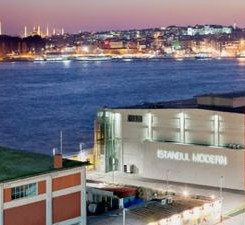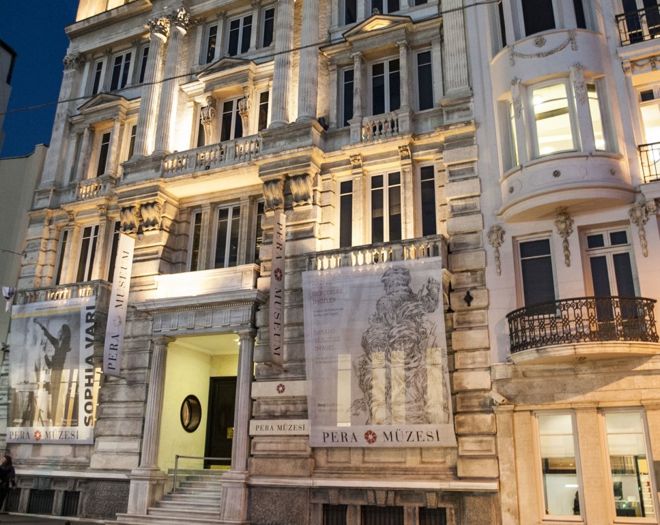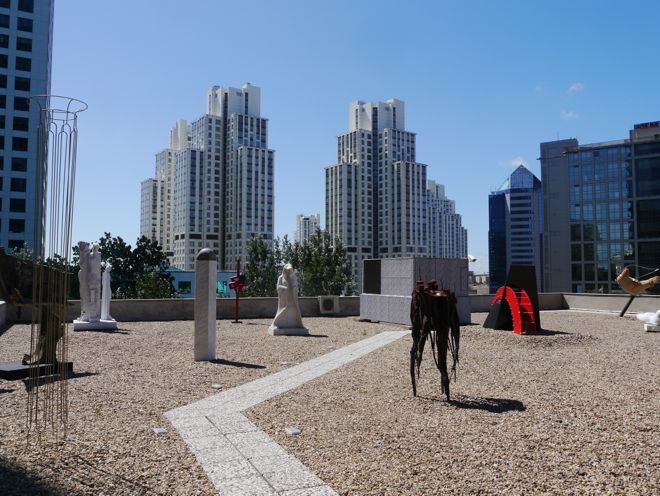Visitors to Istanbul may be forgiven if contemporary art is not high on their agenda. After all, historic sites abound in the “Queen of Cities”—the Hagia Sophia (Ayasofya), the Topkapı Palace, the Blue Mosque, and on and on—while outside preconceptions about “Turkey” and “Istanbul” are slow to change. Yet in fact, Istanbul has seen an art boom of sorts, with new museums, spaces and galleries mushrooming along with the booming economy over the last decade or so. The Istanbul Biennial, soon closing its 15th iteration, has won serious acclaim. There is also the longstanding Contemporary Istanbul art fair (this year, Nov 13–16). In the last five years, a fair few new spaces and museums have joined, with more to come—The Istanbul Museum of Painting and Sculpture (in summer 2015), Koç Contemporary Art Museum (in 2016), and Demsa Museum, Istanbul (in 2016).
What is remarkable is how many, if not most of these institutions being built are privately funded—by conglomerates, banks and such like, often with close ties between them, and often a family affair. The other is how new they mainly are, the oldest being about two decades old. This might remind readers of China’s museum boom—yet in some ways, the institutions built/being built in Istanbul are more well-rounded than their counterparts in China. They are not merely large-scale architectural set-pieces but with well-funded educational programs, fairly high-quality curatorial staff and, impressively, often with libraries (really, considering the terrible state of art education and art resources in China, Chinese museums and institutions should make it a mission to provide resources in printed and digital material to the public).
Below is a quick round-up of the major museums, institutions, and galleries in Istanbul.
(Pronunciation guide: “ç” is like “ch”; “ş” is like “sh”; “ğ” is practically silent; and “i” is like the normal “i”, while “ı” without the dot is like a schwa or “euh”. The umlauts work like German. So “Beyoğlu” is practically “beyolu”, and “Ahmet Öğüt” is something like “Ahmet Oeut”).
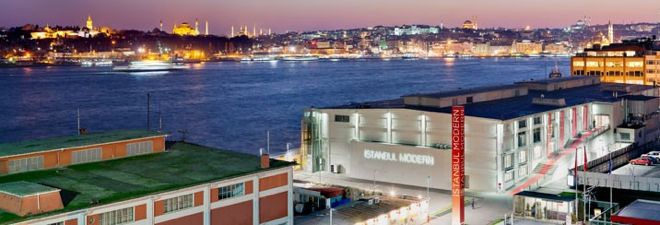
Istanbul Museum of Modern Art (founded in 2004 by the Eczacıbaşı family, with the idea first conceived by Dr. Nejat F. Eczacıbaşı). The surrounding warehouses have hosted the Istanbul Biennial.
(Address: Meclis-i Mebusan Cad. Liman İşletmeleri, Sahası Antrepo No: 4, 34433 Karaköy, İstanbul)
Founded in 2004 by the Eczacıbaşı Group, Istanbul Modern was originally the brainchild of Dr. Nejat F. Eczacıbaşı, who undertook a long, protracted process to secure a space on the stunning Galata (Karaköy) waterfront. Now approaching its tenth anniversary, this private museum hosts a permanent collection showcasing the development of modern and contemporary Turkish art, along with spaces for thematic contemporary exhibitions, a photography gallery, a nook for video art and a cinema and library open to the public, as well as a shop and a restaurant with excellent views of the Bosphorus and Old Constantinople across the Golden Horn (Sultanahmet). The permanent display serves as a good primer on the last century or so of Turkish art, while the thematic section often presents great exhibitions, like the ongoing exhibition “Plurivocality” on the relationship between music and art in Turkey.
The museum is itself a refurbished warehouse, and the warehouses in the immediate area have served as sites for the Istanbul Biennial (next up in 2015), which is run by the Istanbul Foundation for Culture and Arts (İKSV)(this foundation was founded in 1973 by 17 businessmen and enthusiasts under the leadership of the same Dr. Nejat F. Eczacıbaşı, and involves itself in a vast range of cultural activities. (This year, the foundation will run the Istanbul Design Biennial in a different location). The museum’s scale and caliber, along with the biennial, have firmly placed Istanbul on the map of contemporary art. (From a Chinese perspective, it is debatable whether even a single museum in mainland China matches up, despite the 5000 or so museums built over the past decade).
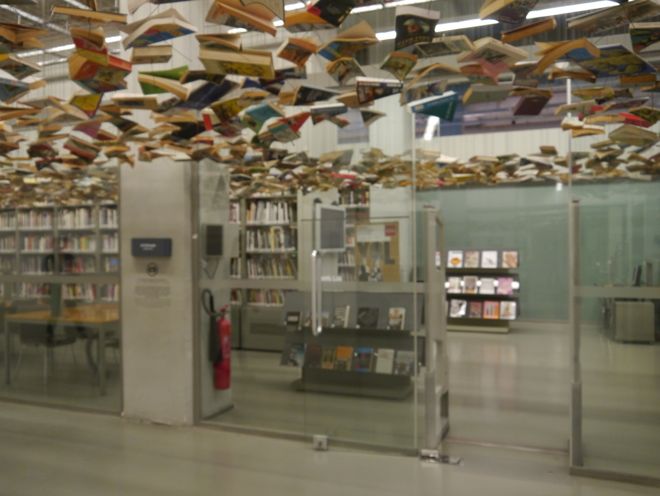
Aside from permanent and temporary exhibition galleries, Istanbul Modern a photography gallery, educational spaces and a cinema, as well as a library.
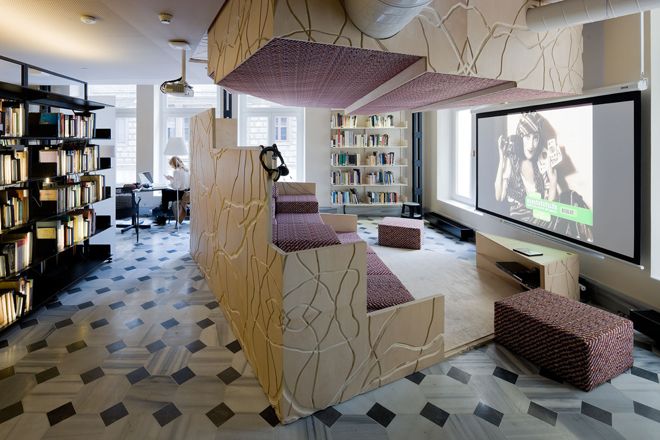
SALT Research (at the Galata space) conducts research and hosts an archival collection of nearly 100 000 printed titles as well as up to a million digital documents.
(address: SALT Galata, Bankalar Caddesi 11, Karaköy 34420 İstanbul; SALT Beyoğlu, İstiklal Caddesi No. 136, Beyoğlu, İstanbul)
Founded in 2011, SALT is a relatively new non-profit organization funded by Garanti Bank. Not quite a museum or a gallery, the institute supports a whole range of activities which include exhibitions but also conferences and research projects. Most impressively, SALT Research has a major archive, with 40 000 printed titles focused on art, architecture, design and urban studies, nearly 100 000 printed titles overall, and up to a million digital documents. SALT Galata is particularly impressive architecturally, since it is housed in the 19th-century former Imperial Ottoman Bank building—with the redesigned Ottoman Bank Museum still in the same structure. While it is still fairly young and still has some rough edges to smooth over, its range of exhibitions (from more crowd-pleasing ones like Christian Marclay’s “Clock” to more experimental and reflexive shows) and the involvement of respected curators like Vasif Kortun means SALT plays a key role within the artistic ecosystem in Istanbul.
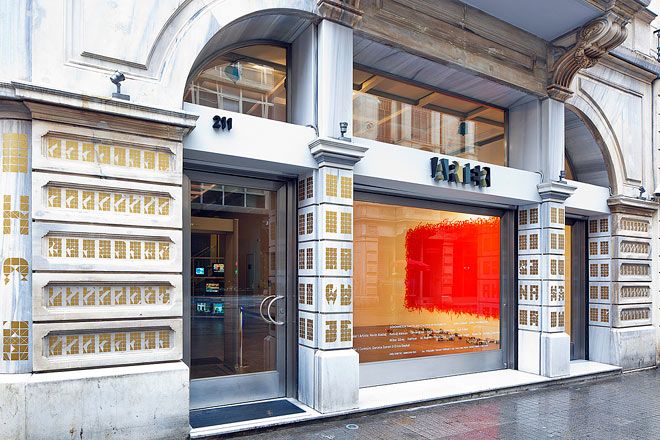
Arter—Space for Art is an invitiative of the Vehbi Koç Foundation. The Koç Contemporary Art Museum is due to open in Istanbul in 2016.
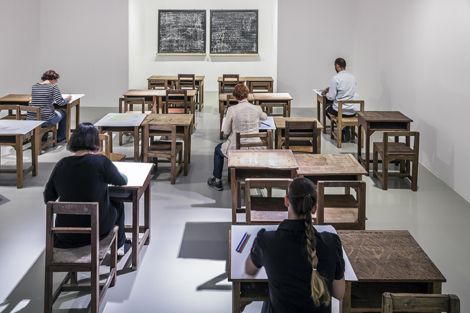
Exhibition at Arter: “The Roving Eye: Contemporary Art from Southeast Asia”. Sutee Kunavichayanont, “History Class Part 2″, 2013 (Photo: Murat Germen).
(Address: Istiklal Caddesi No: 211, 34433 Beyoğlu, Istanbul)
ARTER is a “space for art” founded by the Vehbi Koç Foundation (VKF). Housed in a tasteful mansion on a major shopping street, ARTER has developed something of a reputation as a platform for intelligent and interesting exhibitions. The current show showcases Southeast Asian art (“The Roving Eye”), while past shows have ranged from international artists like Berlinde de Bruyckere, Mat Collishaw and Marc Quinn to renowned Turkish artists like Sarkis and Kutluğ Ataman, to younger artists like Aslı Çavuşoğlu. ARTER is actually conceived as an experimental testing ground for the larger ambitions of the Vehbi Koç Foundation, whose patron, Ömer M. Koç, is a major collector in Turkey himself. Indeed, the Koç Contemporary Art Museum is being built (link to design) and when finished in 2016, it will house the collection of the Vehbi Koç Foundation’s modern and contemporary art collection. Aside from that, Koç Holding is currently also the sponsor of the Istanbul Biennial (from 2007 to 2016).
(Address: Meşrutiyet Caddesi No.65, Tepebaşı, Beyoğlu)
Founded in 2005 by Suna and İnan Kıraç, the Pera Museum has a permanent collection of Orientalist paintings (Western portrayals of Turkey as well as Turkish painters who had learnt oil painting) and Anatolian weights and measures, along with changing temporary collections focused on modern art. Aside from the fascinating historical collection, temporary exhibitions have boasted important modern painters from Picasso and Chagall to Warhol.
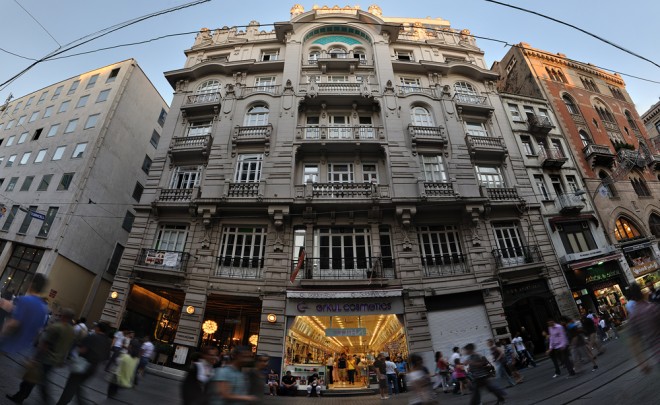
Mısır Apartmanı, host to a number of art galleries and spaces like Cda Projects, Galeri Zilberman, Galeri Nev, Pi Artworks, and the Nesrin Esirtgen Collection.
Mısır Apartmanı
(Address: Misir Aparmani 163/4, Istiklal Caddesi, Beyoğlu, İstanbul)
A gorgeous early 20th-Century Art Nouveau building that was first commissioned by the Khedive of Egypt, Abbas II, Mısır Apartmanı has seen a storied cast of the great and the good over the years. Now, it is a major hub for contemporary art in Istanbul, with a cluster of galleries like Galeri Zilberman (Cda Projects had merged with Galeri Zilberman), Galeri Nev, Gallerist and Pi Artworks (which also has a branch in London), along with Nesrin Esirtgen‘s private collection (she has collected art for 20 years) and a project space called KAT1. To top it off, there is the bar/club/restaurant 360 on the rooftop, with (you guessed it) stunning 360-degree views of the city.
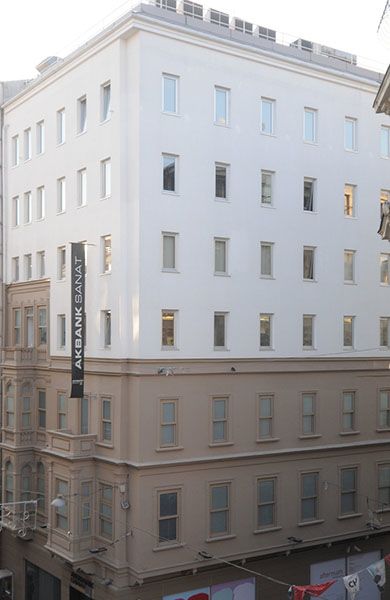
AKBank Sanat, a multi-storey, multi-purpose art and cultural center, including exhibition spaces, print workshop, dance studio, performance space, and a library.
(Address: İstiklal Cad. No:8 34435 Beyoğlu, İstanbul)
Founded over 20 years ago by AKBank, AKBank Sanat is a multi-story art center combining art exhibition spaces, a multi-purpose performance hall and an art studio with a lithograph studio open to artists; there is also a music room, a library and a dance studio. Their involvement in the arts thus extends beyond just contemporary art, with many musical and performance activities included.
Galleries in the central areas of Galata, Beyoğlu, Cihangir, Nişantaşi:
Aside from the galleries within Mısır Apartmanı, there is a range of excellent galleries in the central neighborhoods. Galleries with a strong international presence include RODEO (Sıraselviler Cad. No: 49 / D: 1, Taksim) and RAMPA (Şair Nedim Caddesi, No: 21a, Akaretler 34357 Beşiktaş). There is also the stalwart photography-focused Ellipsis Gallery (Hoca Tahsin Sokak, Akçe Han, No:10, Karaköy).
Around Beyoğlu are the very interesting Galerı NON (Tomtom Mahallesi Nur-i-Ziya sokak No. 16, Beyoğlu), Galeri Manâ (Ali Paşa Değirmeni Sokak, no 16–18, Beyoğlu), and the artist-founded initiative Sanatorium (Asmalı Mescit Mah. Asmalı Mescit Sk. No: 32/A, Beyoğlu) and the alternative space DEPO (Tütün Deposu Lüleci Hendek Caddesi No.12, Tophane).
Around Nişantaşi and Akarelter are RAMPA (see above), CAM (Şair Nedim Caddesi No.25A), Dirimart (Abdi İpekçi Cad. No:7/4 Nişantaşi), X-ist.
Away from central Istanbul:
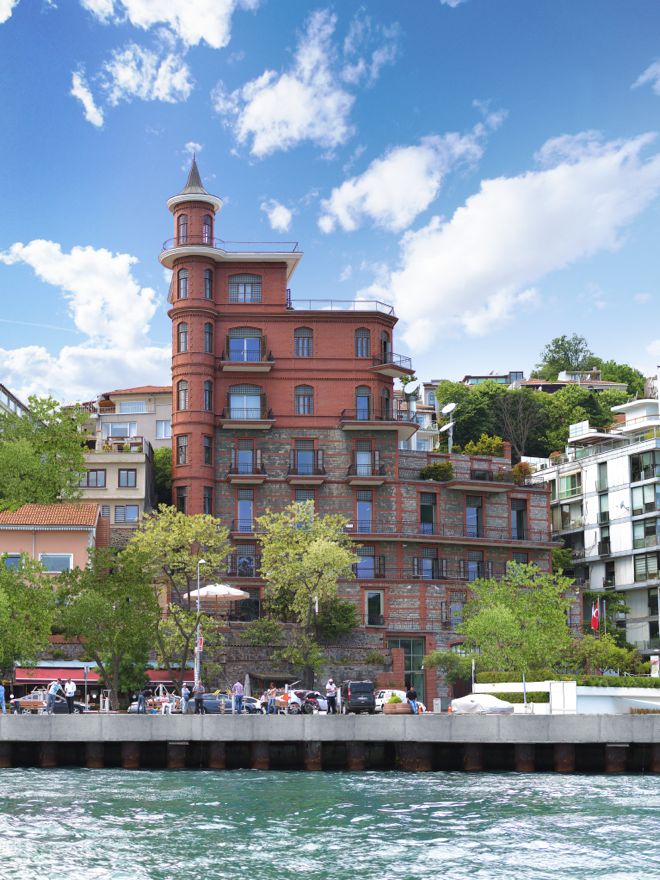
Borusan Contemporary, an office/museum building that hosts both the headquarters of Borusan Holdings and the corporate collection. Access available at weekends.
(Address: Baltalimanı Hisar Street, Perili Köşk No:5, Rumelihisarı, Sariyer)
Further afield to the North is Borusan Contemporary, located in a 100-year-old building on a breathtaking spot next to the Bosphorus, not too far from the suspension bridge linking Europe and Asia. Founded in 2011, Borusan Contemporary serves as the corporate headquarters of Borusan Holdings and displays the corporate collection (over 600 strong). Since it is an actual working space, the space is open to the public only at weekends. Works vary from Sol LeWitt to Doug Aitken to Choe U-Ram—with quite a strong emphasis on video art as well. On the very top, a piece by the Australian artist Andrew Rogers stands before the spectacular view. Well worth a visit—and the office/museum idea is certainly innovative.
Just around the corner is Sakıp Sabancı Museum, a major museum of Islamic calligraphy and Ottoman paintings founded by Sabancı Holding. The museum also hosts temporary foreign exhibitions of modern artists.
Proje4L / Elgiz Museum
(Address: Meydan Sokak Beybi Giz Plaza B Blok, Maslak
Founded in 2001 by the collectors Sevda and Can Elgiz, Proje4L/Elgiz Museum was one of the first non-profit institutions dedicated to contemporary art in Istanbul and is located in the northern business district of Maslak. With a collection of Turkish and international artists—like Tracey Emin, Paul McCarthy, Cindy Sherman—the space is divided into a permanent section, a temporary section, a small library, and a rooftop sculptural space.
(This trip was sponsored by Turkey Tourism and Contemporary Istanbul)



